The Making of "Dance Craze" by Joe Dunton |
Read more at in70mm.com The 70mm Newsletter |
| Joe Dunton interviewed 26.03.2011 by Thomas Hauerslev, during Bradford Film Festival. Transcribed for in70mm.com by Margaret Veedon | Date: 16.04.2011 |
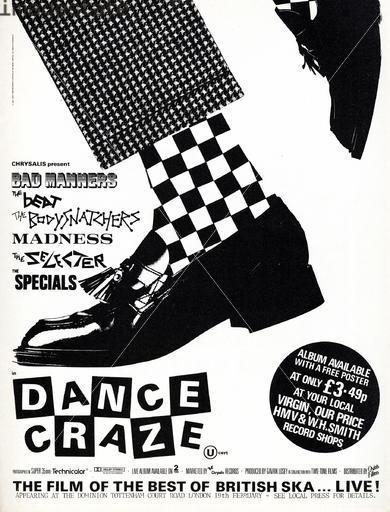 Original
movie advert. Editor's collection Original
movie advert. Editor's collectionTH: We are with Joe Dunton here talking about "Dance Craze" – can you give us some information about "Dance Craze" please? JD: "Dance Craze" was an idea from the director’s son who was at school – he had seen the bands at that time at college and he had said to his Dad, Joe Massot, “You have got to make a film of these bands”. Joe Massot had directed the picture “The Song Remains the Same” with Led Zeplin. I had met him when he used to come into Samuelsons when he was making “The Song remains the Same” and we used to chat. I was basically an engineer and camera person. Five years later he rang me - by then I had my own camera department and I had been working on Super 35 to blow up 70mm: he said he wanted to make this film because of his son. Super16 was to blow up to 35mm. I wanted Super 35 to blow up to 70mm format so you could shoot 1,66 format in Super 16; 1,66 in 35mm; 1,66 in super 35 on the premise we would just get a big negative area and not too much magnification to 70mm. I grew up in the sound department and wanted the magnetic sound which was on the 70mm and not on the optical at that time. During 1978 we had become owners of Steadicams, and I had actually learned how to use it and was able to show everybody else. I probably taught about 50 people in England how to use it; by then we had about five Steadicams. |
More in 70mm reading: Speech for Joe Dunton Joe Dunton Q/A “Dance Craze”: The North American 70mm Engagements Internet link: New York Times review Discography VHS edition HMV store front Muisc in "Dance Craze": "Nite Klub" – The Specials "The Prince" – Madness "Ne-Ne-Na-Na-Na-Na-Nu-Nu" – Bad Manners "007 (Shanty Town)" – The Bodysnatchers "Three Minute Hero" – The Selecter "Ranking Full Stop" – The Beat "Big Shot" – The Beat "Concrete Jungle" – The Specials "Swan Lake" – Madness "Razor Blade Alley" – Madness "Missing Words" – The Selecter "Let's Do the Rock Steady" – The Bodysnatchers "Lip Up Fatty" – Bad Manners "Madness" – Madness "Too Much Too Young" – The Specials "On My Radio" – The Selecter "Easy Life" – The Bodysnatchers "Rough Rider" – The Beat "Man at C&A" – The Specials "Inner London Violence" – Bad Manners "Night Boat to Cairo" – Madness "Twist and Crawl" – The Beat "Wooly Bully" – Bad Manners "Too Much Pressure" – The Selecter "Mirror in the Bathroom" – The Beat "One Step Beyond" – Madness "Nite Klub" – The Specials |
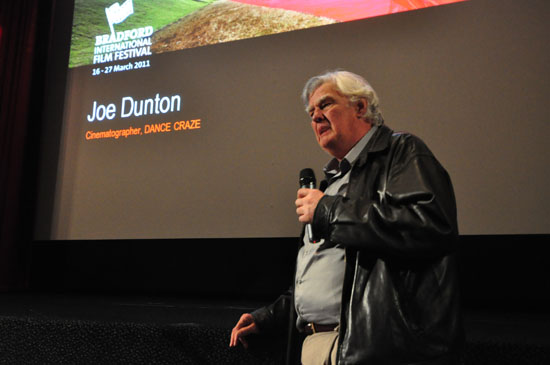 Joe
Dunton talking about the film; "Dance Craze". Image by Thomas Hauerslev Joe
Dunton talking about the film; "Dance Craze". Image by Thomas HauerslevI then had the idea to make a film that was not “a third row film”, - not shot from the audience, from the third row; everyone shot concert films from the third row, and it does not mean anything, and because the bands were young bands I ended up being on stage with them and our first band – I think it was called “The Specials” or “Selecter” – I asked if I could come on stage and make the film; they had not made a film before so they were not really anti-me at all. I said if they did not like the film we need not use it; thus we did not draw up contracts – we just took a chance. After the first concert, we hired a cinema in Brighton (or Southampton) with no sound – and the band saw the film – and they sang along with the film because they knew the words – so we had sound as they sang along with it. They told their mates in the other bands of this whole 2 tone group and what we were doing. I got permission from all of them in the end. |
Hej Thomas, The interview was an important one in that it added a very valuable first hand account which bore witness to the superiority of 70mm as opposed to digital HD, which is only really glorified TV after all. The insights into colour ("Cleopatra" gold) and resolution were particularly interesting. All the best, M&M |
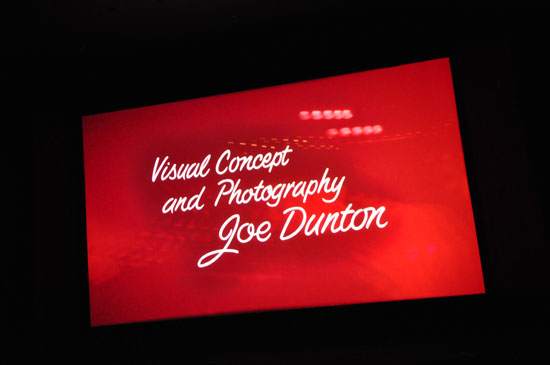 Joe
Dunton on-screen film credit from "Dance Craze". Image by Thomas Hauerslev Joe
Dunton on-screen film credit from "Dance Craze". Image by Thomas HauerslevUnfortunately, with Joe, he was a lovely man, but was American and when you come from Camden Town – our Cockney London - to have an American to deal with it was very difficult. So I was the communicator - basically because my camera was being directed by me – not someone telling me what to do. I was just feeling the way. TH: it was a first person experience. JD: Yes – the other part of this puzzle was that I felt we were recoding a period of time really well – because we record on 24 track magnetic – most people just put in a Nagra recorder and record the sound in a club; and a club sound is a club sound, but this was properly recorded by some Abbey Road mobiles and a Rolling Stones mobile so we had ace quality recordings of sound live 24 microphones out on a little tiny stage of people. |
|
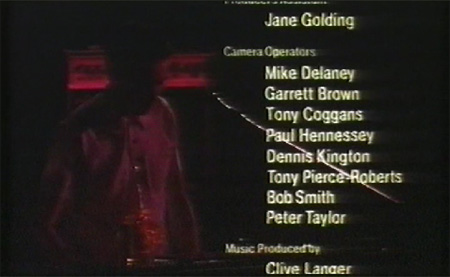 Note
famous names among the camera operators in the film. Image by Thomas
Hauerslev Note
famous names among the camera operators in the film. Image by Thomas
HauerslevI made the format of film out of Super 35 which was a 1,66 format - full aperture format – I did not know at the time, but I found out afterwards, it was Superscope - or a poor man’s Vista Vision according to Disney! I had made this now Super 35 because it was meant to blow up to 70mm. I had found a lovely man – Don Toms, with Technicolor - who did the blow up for me; he did the direct negative to print - 70mm direct negative to print - so you had no quality loss; you had direct blow up to print, six tracks of sound; an optical blow up to print. If you look at the credits, the crew were mainly from my camera hire shop; there were a few of my cameraman friends as operators, but the crew who operated the cameras were from my shop. We used to go in the evenings and make the film; with perseverance, and the idea that everybody was really behind us; it was a time in life that we will never see again. (It would be nice to know who owns the film) |
|
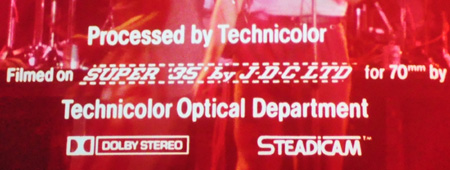 70mm
credited in the film. Image by Thomas Hauerslev 70mm
credited in the film. Image by Thomas HauerslevWe finished the film. I ended up with a contract that offered me 10% of the movie and then – as in those days - I got a telex from Chrysalis Records to say it was 1%. I told them they had left the “0” off: no, no, they said we have done a new deal – I still never got my wages then. But I had 30 people on the payroll editing the film so they really pushed me into saying let’s get on and finish the film. I still have not got my 1per cent! - it should be mounting up over 20 years! – (it would be good if you could put the word out!) – the director had a 10% too and he has now passed away, although his daughter could do with the money; there must be revenue from it. What happened to the film? We premiered it in the Astoria Tottenham Court Road, Big 70mm theatre – with a few press people – I made the press see it in 70mm; it ran for two weeks in a West End theatre, which I think was good. We made 28 Dolby prints – Dolby was just out. |
|
 Bill
Lawrence and Joe Dunton talking about the film; "Dance Craze". Image by
Thomas Hauerslev Bill
Lawrence and Joe Dunton talking about the film; "Dance Craze". Image by
Thomas HauerslevWhy I went magnetic? – because Dolby had really only just started and magnetic was the best audio quality at that time – it still is – the analogue audio is still my favourite. It would be interesting to see how the sound holds up here in Bradford. The releasing company went broke, but the Rank Organisation was showing the film around England – (we had 28 prints made) – and then they pulled it; mainly because we had a sequence in the film that theoretically the projector breaks down and we put a newsreel film on (which I had to do because you could not sustain 90 minutes of music unless you are on dope or something!) |
|
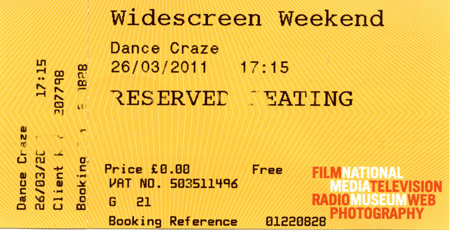 TH: that would be too much! TH: that would be too much!JD: so I broke it up with an old newsreel – the newsreel shows an old coffee shop called the Macabre Coffee Bar, which I used to go to; so it is a bit of history for me, and it was about the early "Dance Craze". So it was nice; it gives you the break needed, and then you go back into the music again. It is all on Steadicam - 90% of it on Steadicam. We used long lenses such as 300mm and 600mm from the auditorium. A wide shot of the stage would have shown me with the Steadicam – so to get round that I was on the stage with a big wide lens, they would do other shots and miss me. |
|
 Madness
in the film; "Dance Craze". Image by Thomas Hauerslev Madness
in the film; "Dance Craze". Image by Thomas HauerslevMy daughter has now made a film on 600mm – 80% of the movie shot on a 600mm lens; it is anamorphic – always anamorphic. I realised that with 1,66 I could not shoot Westerns – it had to be CinemaScope. I started researching CinemaScope, and I realised that CinemaScope was quite good – when the lenses are good, it is very nice. Panavision: I was working at that time with Panavision they were going through this big, big time of movies with fog filters and black nets on them, and they looked ghastly focus-wise – they did not look nice, not crisp; you can make a picture that is not crisp but is still aesthetically pleasing to the eye rather than an out of focus picture. There is a bridge in there. Anamorphic: I started specialising in anamorphic – as you can blow anamorphic up to 70mm. My love for 70mm came originally from “Oliver” the musical; I worked on that for six months – (from being a black and white television engineer to working on this big musical?!). I gave up television because you could not compete. There was no competition at that time between black and white TV 405 lines and this wonderful world of CinemaScope or Panavision anamorphic. |
|
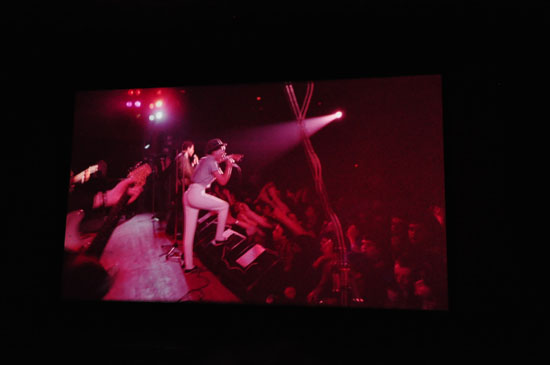 Velvet-like
picture quality of the film; "Dance Craze". Image by Thomas Hauerslev Velvet-like
picture quality of the film; "Dance Craze". Image by Thomas HauerslevAnd that is what set me up on the road to pictures - of loving big pictures and forever now I have been selling people Big Pictures – even if it is a film student, if he makes a very short film in anamorphic everyone starts to respect him. He understands what he is making. So my criterion was - if someone asks me for a camera, I ask “What do you want to do with it?” – “Do you want to show it in a cinema, or on a DVD show grill?” Once they have been hooked into a cinema, they will always want Super 16. I ask who has got the money to blow it up to 35mm to show in a cinema. Then I would sell them an idea about 35mm with all short ends; then I would sell them the idea of going anamorphic 35mm. So, they came to me for Super 16 and went out with CinemaScope, but they loved it – they never forget it. Once you have seen a big picture – even if it is “This is Cinerama”, you always remember those shots in your brain - the helicopter shot in “Sound of Music”; some of the scenes from “Oliver”. My belief is that good 70mm has so much information in the picture that your brain thinks you were there. That concept is not sold today. |
|
 Joe
Dunton looking at the screen. Image by Thomas Hauerslev Joe
Dunton looking at the screen. Image by Thomas HauerslevTelevision: HD is HD but it is more than HD - with TV it is difficult to produce good colour; it is about the quality range of colours that you see. In TV it is difficult to do a gold colour because there is no yellow in the system – it is red, green and blue mixed; so you would find it difficult to make gold if you were doing "Cleopatra" where everything is gold. You would find it difficult in HD to show the beautiful texture of gold. I do not know if that means anything – for me it means that this was, at that time, the best way to get the maximum technical quality from a piece of 35mm. I think if we were to really push anamorphic blown up, or anamorphic negative, I think there is some 11k of information in an anamorphic negative, because it is such a big negative, and if you get really lovely lenses, not only sharp, but an aesthetically sharp negative – that is part of the puzzle – you do not just want clinically sharp negatives. |
|
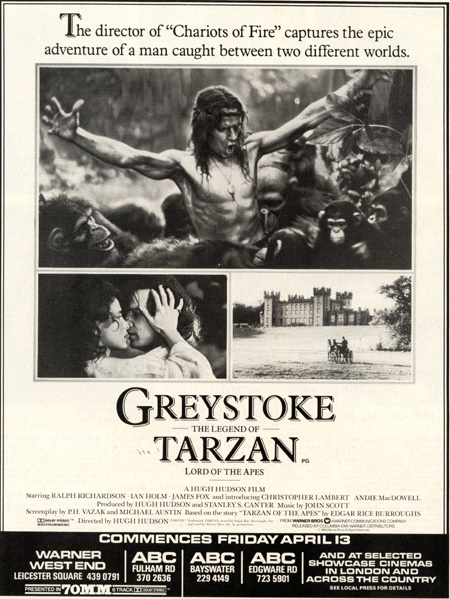 Vintage
advert for "Greystoke"'s London release with two 70mm prints. Editor's
collection Vintage
advert for "Greystoke"'s London release with two 70mm prints. Editor's
collectionTH – “What came off when you essentially made "Dance Craze" as a demonstration film – in Super 35 – what did the director say? JD: Just after I had finished the film - and we had set up the optical printer and had got the bugs out of the system - in my lifetime you have to show people or they do not believe you – so you have to show them the pictures. Hugh Hudson at that time was just starting Gracelands, and we had set up the optical printer – we had made the film and made the prints in the first Super 35 and then I spoke with a lady called Joyce Hurley who was the production lady of "Greystoke". Hugh Hudson and I saw the models of the sets they had made up; I said “you have got to make this in 70mm” (I admitted I was passionate about this method), - but he said he could not do it at this stage. Hugh Hudson owned his own camera at that time and he was a lens fanatic – a bit like Stanley Kubrick – he had his own lenses and his own camera. He then wanted to go CinemaScope – so we make 2,35 Super 35 not 1,66 Super35 which was the old Technirama system; you get a bit bigger negative but you lost a lot of negative because you cropped it down. He was the first person to make a 70mm print from 35mm in the new wave of Super 35 from 35mm – he launched it with "Greystoke" – and got the kudos from the Super 35mm. |
|
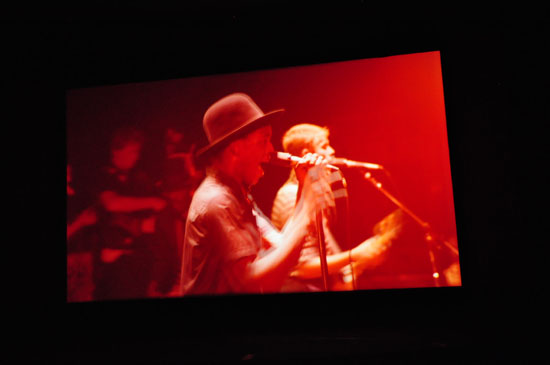 Mr.
"Steadicam" Garret Brown himself, seen in the background. Mr.
"Steadicam" Garret Brown himself, seen in the background.They made 17 prints of the 70mm print, off the negative, without telling the bank. They ran the negative 17 times on an optical printer to make the prints. If you find a 70mm print of "Greystoke", which is made from that negative, it will look incredible. They had to then make an optical reduction 35mm to make CinemaScope prints – which were all right but once you go that way it loses the edge of the quality. |
|
Sound recording | |
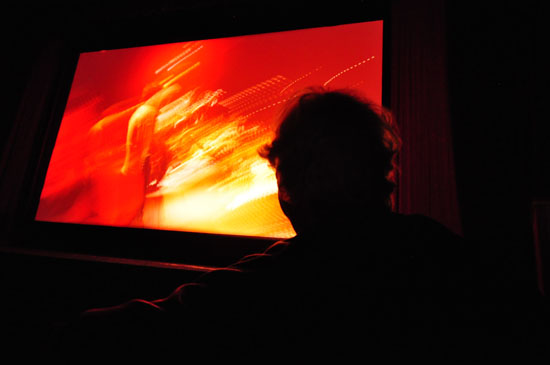 Joe
Dunton's silluette looking at "Dance Craze". Image by Thomas Hauerslev Joe
Dunton's silluette looking at "Dance Craze". Image by Thomas HauerslevTH: Can you talk a little about the sound recording – the mixing: JD: A friend at the time – a young chap whose Dad was at Samuelsons - had gone to work for Abbey Road; so I had a good connection into Abbey Road Studio, the Beatles studio. We then took the pictures, converted them to tape, Umatic, and remixed the pictures with a monitor on the mixing desk of Abbey Road. The bands were able to do a small amount of editing - if they wanted to do an extra remix, or if someone made an error with the guitar, you could fix it. We now had this 24 track tape mixed at Abbey Road. We got the best out of the sound and went on to mix the 6-track in Elstree Film Studios – in Dolby split surround, although it was not real Dolby at that time. |
|
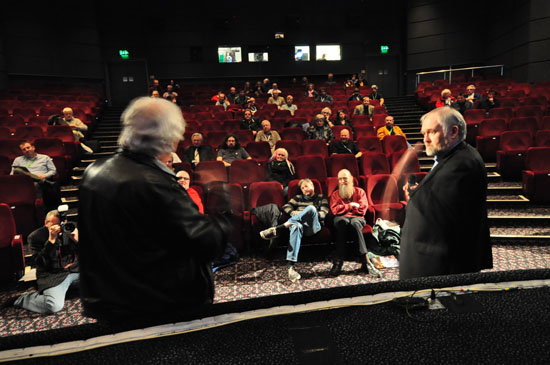 Pictureville
audience listening to Joe's stories after the first screening of "Dance
Craze" in 30 years. Image by Thomas Hauerslev Pictureville
audience listening to Joe's stories after the first screening of "Dance
Craze" in 30 years. Image by Thomas HauerslevDolby: Dolby was available then but not as it has become – it was more mono. We were looking for a Dolby ‘split surround’, which had only just been used by George Lucas before that with "Star Wars". So you could, for instance, have an aircraft coming in from the left and going off on the right – not just a background sound. It was like a first for that as well. |
|
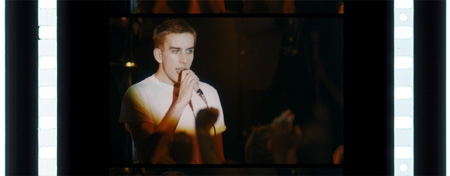 70mm
frame blow-up by Schauburg Kino 70mm
frame blow-up by Schauburg KinoIt was a proper 24 track recording, photographed in a big negative area. I would set the focus at a high focal distance because it was moving around. There was a new wide angle lens available that I used. I used a Steadicam - that was new - and it was there for posterity; it has only been run twice since then. It was run in the theatre in New York for a one night screening – filling the house on a one night screening - and I showed it in Nashville to Whispering Bill Anderson, because I wanted to make a one night at the Grand Old Opry; this looks like a one night concert - with band changes. |
|
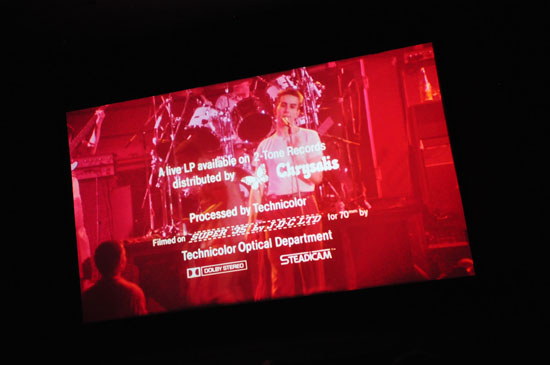 There is no dialogue which means the world can see it - with no dialogue
you need no sub-titles ! There is no dialogue which means the world can see it - with no dialogue
you need no sub-titles !TH: asked was it released widely in the States? JD: Yes, but Rank did not explain that there was a deliberate break in the middle of the film and, when it happened, the audience went wild because they thought the projector had broken down. So Rank took it off the circuit, but it was all over England - all 28 prints – it was not a particularly big release but it was big for that time. I was so fed up with Rank that, when one man in America, a distributor, said he liked the film I sent him all the prints. I said if you like it you can have the prints; it is very famous in a way in America because it would run alternate weeks to "Rocky Horror Show" on a Saturday night, and then "Dance Craze" the next night, and then every Saturday it ran on the student networks. In Chicago there is a 2 Tone Ska Radio Station – it has a phenomenal following. I am not sure where this man is now, but one day I shall find him! |
|
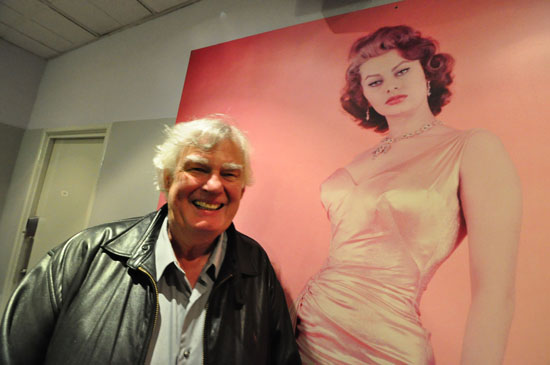 Image
by Thomas Hauerslev Image
by Thomas HauerslevThat is why I am excited to actually see the film here in Bradford and I am about to try and make a HD copy on Blu-ray, which I will grade myself. I never really meant it to go on tape because I wanted people to experience the 6-tracks of sound and the whole environment. TH: do you still have the negative of the sound? JD: No, I have not, but I have a Dolby 35mm print – a good print – and with the electronics today you can make it look nice. You will see from this print that it is very dark and the blacks have got tiny bits of red in them, but it looks as though I meant it to be that way! There is so much work you can do these days electronically, I know I can make it look very nice. Or I may even scan the 70m print of it and do it – if the money can be found. |
|
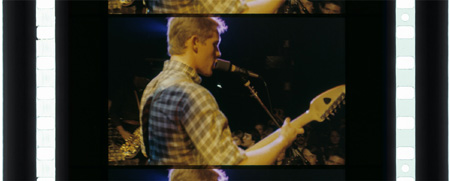 70mm
frame blow-up by Schauburg Kino 70mm
frame blow-up by Schauburg KinoTH: How many of the 70mm prints do you have? JD: one! – this is it! – very unique! TH we are looking forward to seeing it tonight. JD: yes just think after all this time – it is over 20 years since you in England saw it. I must have seen it 200 times when I made it. |
|
Tony Sloman joined for a few moments | |
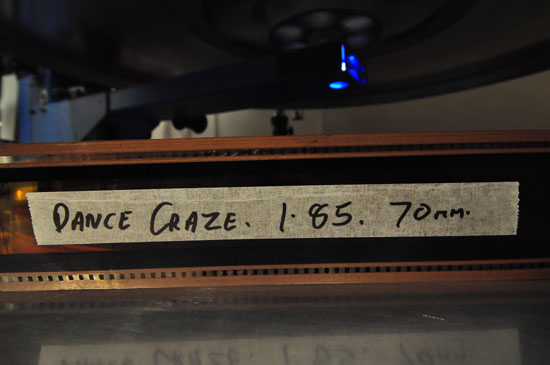 Image
by Thomas Hauerslev Image
by Thomas HauerslevTony Sloman: joined for a few moments on his way through – he said he was looking forward to seeing the film and would be introducing it – JD admitted that the colour of the blacks in the film had got a tiny bit of red but it looks as though it was meant to be! They enthused that it was 30 years since it was screened at the Dominion Tottenham Court Road. The Astoria in Charing Cross Road was a newspaper presentation. Tony said he felt sure there is a market for a technically updated version of this film. TH: said it is thanks to Tony we are showing it here in Bradford at the Film Festival 2011; he has been talking with Tony about "Dance Craze" for 20 years. – JD told him that he had just one print which he was trying to do something with – although to Tony’s question as to who actually owned the print, Joe Dunton admitted he was not sure! Doubtless someone would come forward at some stage. JD said that from the one print he had left he would make a Blu-ray. It will be interesting, if this comes about, if someone comes forward to say he owns it! |
|
| Go: back - top - back issues - news index Updated 22-01-25 |
